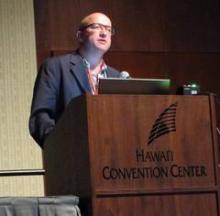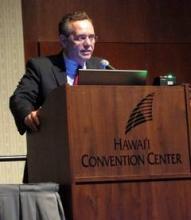Dr. Lewis Morgenstern, an epidemiologist and director of the stroke program at the University of Michigan, Ann Arbor, observed that even in the West where stroke incidence and mortality are declining, "Stoke is becoming more and more a disease of the poor and underserved."
He called on clinicians to address these disparities through global research agendas and advocacy, but also to reach out locally to poor and underserved populations with stroke prevention and preparedness messages. As for what they should emphasize, he highlighted a recent estimate that the cost of an endovascular procedure is at least $10,000, whereas a 1-month supply of the blood pressuring–lowering diuretic hydrochlorothiazide 25 mg costs $4.
Neuroprotection
After more than a decade developing a class of drugs called postsynaptic density-95 (PSD-95) protein inhibitors, the ENACT trial recently provided a positive signal that neuroprotection is achievable, said study coauthor Dr. Michael Tymianski, a neurosurgeon at the University of Toronto.
Like reperfusion therapies, however, neuroprotectants are emergency drugs that need to be administered in a prehospital setting. Only two trials, ENACT and the ongoing FAST-MAG, have recruited stroke patients in less than 4 hours. Thus, any new clinical trial design that waits 3-4 hours before administering neuroprotective agents is unlikely to detect the small effect size of delayed neuroprotection, he noted.
That said, we now have an effective drug and a feasible trial design. Planning is underway for a study that, if successful, may provide the necessary signal needed to determine whether neuroprotection is practical, Dr. Tymianski said.
‘Garbage in, garbage out’
Dr. Steven Warach, executive director of the Seton/University of Texas Southwestern Clinical Research Institute in Austin, made a plea for scientific rigor in future clinical trials to avoid the "garbage in, garbage out" type of research that just adds noise to the field.
Over the next 10 years, clinical trial enrollment and assessment will move away from the individual investigator. Instead, a "handful of on-call central adjudicators" will decide which patients get into trials based on both clinical and biologic case definitions and will assess outcomes.
"It’s all about three things. Whatever advances we talk about in clinical science, it’s about reducing bias, reducing variance, and increasing the power of the trials," he said.
The conference was sponsored by the American Heart Association.
Dr. Nudo reported research support from the National Institutes of Health and the Department of Defense and disclosed ties with Microtransponder. Dr. Stein disclosed research funding from Tibion, Tyromotion, and Myomo, and ties to Myomo. Dr. Sacco, Dr. Feigin, Dr. Morgenstern, Dr. Tymianski, and Dr. Warach reported having no disclosures.



